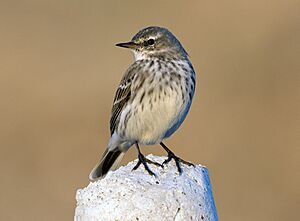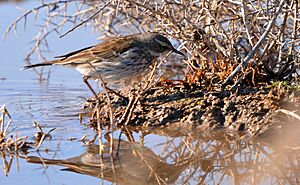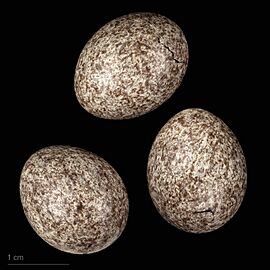Water pipit facts for kids
Quick facts for kids Water pipit |
|
|---|---|
 |
|
| A Water Pipit (Anthus spinoletta spinoletta) | |
| Conservation status | |
| Scientific classification | |
| Genus: |
Anthus
|
| Species: |
spinoletta
|
 |
|
| Where the Water Pipit lives: Breeding Resident Passage Non-breeding | |
| Synonyms | |
|
|
The water pipit (Anthus spinoletta) is a small passerine bird. It lives in the mountains of Southern Europe and Asia, all the way to China. These birds are migrants, meaning they move to warmer, lower areas in winter.
When it's time to breed, the water pipit has grey-brown feathers on its back. Its belly is a pale pink-buff color. It has a white "eyebrow" stripe above its eyes. In winter, its colors are duller, and its belly is white with light brown streaks. Male and female water pipits look almost the same. Young birds look like adults.
Water pipits build their nests on the ground or in cracks in cliffs. They lay four to six eggs. These eggs hatch in about two weeks. The young birds are ready to fly in about two more weeks. Water pipits mainly eat small invertebrates like insects. They find these on the ground or on plants. They also eat some plant material.
Birds of prey sometimes hunt water pipits. Pipits can also get fleas or other parasites. Sometimes, a common cuckoo might lay its egg in a pipit's nest. But overall, there are many water pipits, and their numbers are steady. Because of this, the International Union for Conservation of Nature (IUCN) says they are a species of least concern. This means they are not currently in danger.
Contents
About the Water Pipit
The water pipit belongs to a bird family called Motacillidae. This family includes wagtails and longclaws, but mostly pipits. Pipits are usually brown birds that eat insects and live on the ground. It can be tricky to tell different pipits apart because they look so similar.
The water pipit is closely related to the European rock pipit. They were once thought to be the same species. Other relatives include the meadow pipit and red-throated pipit.
The famous scientist Carl Linnaeus first described the water pipit in 1758. He called it Alauda spinoletta. Later, in 1805, a German naturalist named Johann Matthäus Bechstein created the group, or genus, Anthus for pipits. The name Anthus is a Latin word for a small grassland bird. The word spinoletta comes from a local Italian word for a pipit.
There are three main types, or subspecies, of the water pipit:
- Anthus spinoletta spinoletta: This type lives in the mountains of southern Europe, from Spain to Turkey. It also lives on the islands of Sardinia and Corsica.
- Anthus spinoletta coutellii: This type breeds in the mountains of Turkey, the Caucasus region, Iran, and Turkmenistan.
- Anthus spinoletta blakistoni: This type lives in mountains across Asia, from southern Russia to central China.
What Does a Water Pipit Look Like?
The water pipit is about 15 to 17 centimeters (6 to 7 inches) long. It weighs about 19 to 23 grams (0.7 to 0.8 ounces).
In spring, the adult water pipit has grey-brown feathers on its back. Its belly is a pale pink-buff color, becoming whiter lower down. It has a clear white stripe above its eye, like an eyebrow. Its outer tail feathers are white. Its legs, beak, and eyes are dark brown or black.
In winter, the head is more grey-brown. The white eyebrow stripe is not as bright. Its back has more streaks, and its belly is white with light brown streaks.
Male and female water pipits look very much alike. Females might have a slightly greyer head. Young birds look like adults in winter, but they are browner and have more streaks.
The water pipit is similar to the European rock pipit and the meadow pipit. However, the water pipit has longer wings and tail than the meadow pipit. It also has much paler underparts and dark legs, not pinkish-red ones. Compared to the European rock pipit, the water pipit has a stronger white eyebrow. Its back is greyer, and its outer tail feathers are white, not grey.
Water Pipit Sounds
The water pipit sings from a perch or while flying. Its song has four or five parts. Each part repeats a short note about six times.
The water pipit's call is a sharp "dzip." It can be a single sound or a double sound. This call is a bit harsher than the soft "sip sip sip" of the meadow pipit. It is also different from the shrill "pseep" of the European rock pipit.
Where Do Water Pipits Live?
The water pipit breeds in the mountains of southern Europe and Asia. Its range stretches from Spain all the way to central China. It also lives on the Mediterranean islands of Sardinia and Corsica.
During the breeding season, water pipits live mostly in mountains. They prefer high meadows and alpine pastures. These areas have short grass and some bushes or rocks. They are often found near wet areas and on slopes. They breed at altitudes from about 600 to 3200 meters (2,000 to 10,500 feet). Most breed between 1400 and 2500 meters (4,600 to 8,200 feet).
In autumn, they fly shorter distances to lower areas. They spend winter in coastal wetlands, marshes, and rice fields. Some birds stay at higher altitudes, up to 2000 meters (6,600 feet).
Water pipits leave their breeding sites starting in mid-September. They begin their spring migration in February and March. They arrive back at their breeding grounds in April and May.
Water Pipit Behavior
The water pipit is a bit shy compared to the European rock pipit. If you get too close, it will fly a good distance away before landing again. The rock pipit usually flies only a short distance, staying low to the ground.
Reproduction and Life Cycle
Water pipits are mostly monogamous. This means one male and one female pair up. The male performs a display flight. He flies up to 10 to 30 meters (30 to 100 feet) high, then glides down in an arc, singing all the while.
The female builds a cup-shaped nest. She uses grass and leaves, lining it with finer plant material and animal hairs. The nest is hidden in plants on the ground, sometimes in a small hollow.
They usually lay four to six eggs. This happens from late April to early July. The eggs are greyish-white with darker speckles. They are about 21 by 16 millimeters (0.8 by 0.6 inches) in size.
The female sits on the eggs to keep them warm. This is called incubation. It takes 14 to 15 days for the eggs to hatch. The male feeds the chicks at first. After a few days, both parents share the job. The young birds are ready to fly in another 14 to 15 days. Water pipits can have two sets of chicks in one year.
In one study, 76% of eggs hatched, and 58% of chicks learned to fly. In another study, 90% of eggs hatched. But only 47% of those chicks survived to fly. Nests built earlier in the season were more likely to fail. This was because there was less plant cover to hide them from predators.
What Do Water Pipits Eat?
Water pipits like to find food in damp grasslands. This is different from the rocky coasts where European rock pipits feed. Water pipits mainly eat many different invertebrates. These include crickets and grasshoppers, beetles, snails, millipedes, and spiders. Young birds also eat barkflies, true flies, caterpillars, and homopterans.
Near snow fields, they eat insects that live in cold places. These include springtails like the glacier flea and a type of scorpion fly.
Water pipits usually look for food alone or in pairs. If the weather is bad, they fly more often and for longer to find food. They might gather near marmot burrows. Most of their food is caught by walking on the ground. But they sometimes catch flying insects in the air. They also eat some plant material.
In areas where the soil is acidic, there is less calcium. This can make eggshells thinner. In these places, pipits are more likely to eat snails. Snails have shells rich in calcium, which helps the birds get enough of this important mineral.
Dangers and Health
Birds of prey, like the Eleonora's falcon, hunt water pipits. Eggs and young birds can be eaten by land animals like stoats and snakes.
Like other pipits, the water pipit can be a host for the common cuckoo. Cuckoos are brood parasites. This means they lay their eggs in other birds' nests. Cuckoo eggs that are laid in pipit nests often look similar to the pipit's own eggs.
Water pipits can also have tiny creatures called feather mites on their feathers. They can also have fleas. These include Ceratophyllus borealis and Dasypsyllus gallinulae. They can also carry a tiny parasite called Haemoproteus anthi.
Conservation Status
There are many water pipits in Europe. Estimates suggest there could be up to two million pairs. This means there are tens of millions of water pipits worldwide. They live across a huge area, about 3.7 million square kilometers (1.4 million square miles).
Even though their habitat is spread out in mountains, the total number of water pipits is large and stable. Because of this, the IUCN has listed the water pipit as a species of least concern. This means it is not considered to be in danger of extinction.






